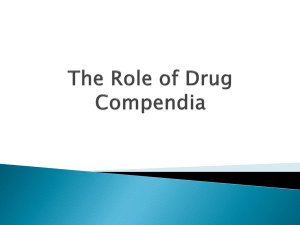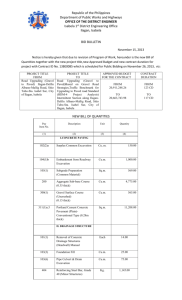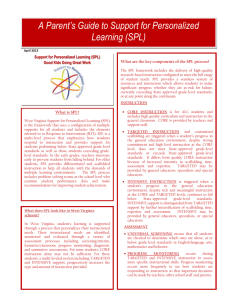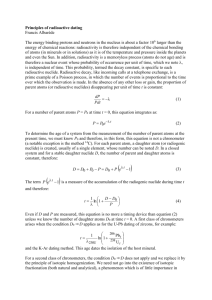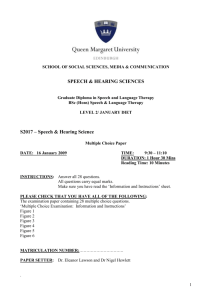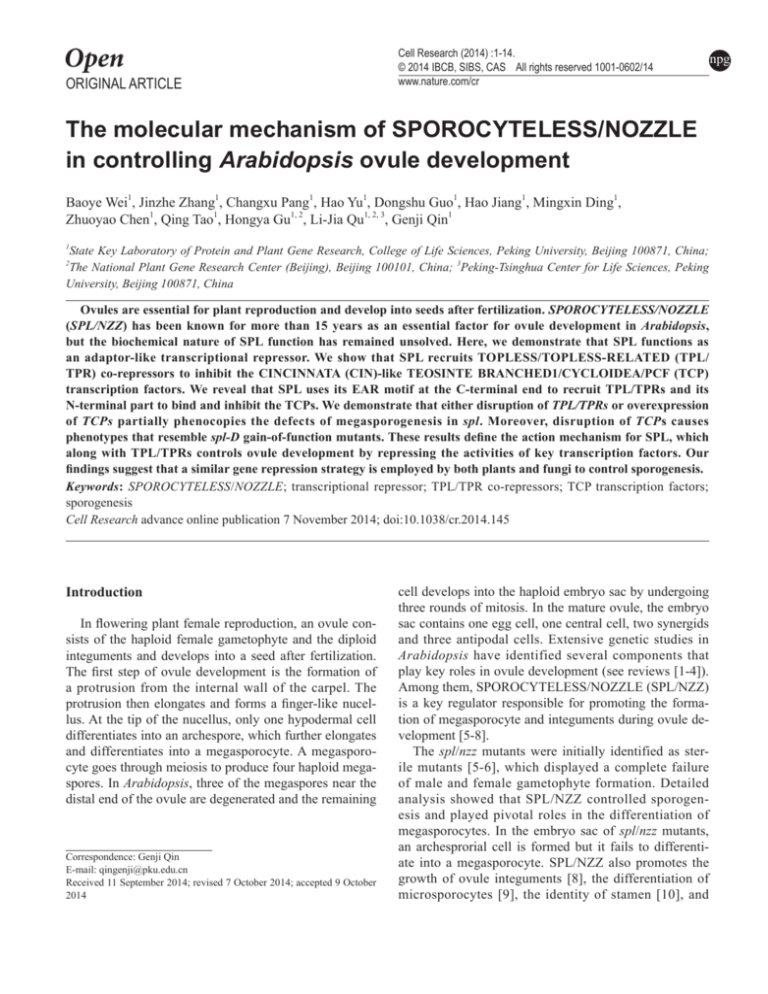
ORIGINAL ARTICLE
Cell Research (2014) :1-14.
© 2014 IBCB, SIBS, CAS All rights reserved 1001-0602/14
www.nature.com/cr
The molecular mechanism of SPOROCYTELESS/NOZZLE
in controlling Arabidopsis ovule development
Baoye Wei1, Jinzhe Zhang1, Changxu Pang1, Hao Yu1, Dongshu Guo1, Hao Jiang1, Mingxin Ding1,
Zhuoyao Chen1, Qing Tao1, Hongya Gu1, 2, Li-Jia Qu1, 2, 3, Genji Qin1
1
State Key Laboratory of Protein and Plant Gene Research, College of Life Sciences, Peking University, Beijing 100871, China;
The National Plant Gene Research Center (Beijing), Beijing 100101, China; 3Peking-Tsinghua Center for Life Sciences, Peking
University, Beijing 100871, China
2
Ovules are essential for plant reproduction and develop into seeds after fertilization. SPOROCYTELESS/NOZZLE
(SPL/NZZ) has been known for more than 15 years as an essential factor for ovule development in Arabidopsis,
but the biochemical nature of SPL function has remained unsolved. Here, we demonstrate that SPL functions as
an adaptor-like transcriptional repressor. We show that SPL recruits TOPLESS/TOPLESS-RELATED (TPL/
TPR) co-repressors to inhibit the CINCINNATA (CIN)-like TEOSINTE BRANCHED1/CYCLOIDEA/PCF (TCP)
transcription factors. We reveal that SPL uses its EAR motif at the C-terminal end to recruit TPL/TPRs and its
N-terminal part to bind and inhibit the TCPs. We demonstrate that either disruption of TPL/TPRs or overexpression
of TCPs partially phenocopies the defects of megasporogenesis in spl. Moreover, disruption of TCPs causes
phenotypes that resemble spl-D gain-of-function mutants. These results define the action mechanism for SPL, which
along with TPL/TPRs controls ovule development by repressing the activities of key transcription factors. Our
findings suggest that a similar gene repression strategy is employed by both plants and fungi to control sporogenesis.
Keywords: SPOROCYTELESS/NOZZLE; transcriptional repressor; TPL/TPR co-repressors; TCP transcription factors;
sporogenesis
Cell Research advance online publication 7 November 2014; doi:10.1038/cr.2014.145
Introduction
In flowering plant female reproduction, an ovule consists of the haploid female gametophyte and the diploid
integuments and develops into a seed after fertilization.
The first step of ovule development is the formation of
a protrusion from the internal wall of the carpel. The
protrusion then elongates and forms a finger-like nucellus. At the tip of the nucellus, only one hypodermal cell
differentiates into an archespore, which further elongates
and differentiates into a megasporocyte. A megasporocyte goes through meiosis to produce four haploid megaspores. In Arabidopsis, three of the megaspores near the
distal end of the ovule are degenerated and the remaining
Correspondence: Genji Qin
E-mail: qingenji@pku.edu.cn
Received 11 September 2014; revised 7 October 2014; accepted 9 October
2014
cell develops into the haploid embryo sac by undergoing
three rounds of mitosis. In the mature ovule, the embryo
sac contains one egg cell, one central cell, two synergids
and three antipodal cells. Extensive genetic studies in
Arabidopsis have identified several components that
play key roles in ovule development (see reviews [1-4]).
Among them, SPOROCYTELESS/NOZZLE (SPL/NZZ)
is a key regulator responsible for promoting the formation of megasporocyte and integuments during ovule development [5-8].
The spl/nzz mutants were initially identified as sterile mutants [5-6], which displayed a complete failure
of male and female gametophyte formation. Detailed
analysis showed that SPL/NZZ controlled sporogenesis and played pivotal roles in the differentiation of
megasporocytes. In the embryo sac of spl/nzz mutants,
an archesprorial cell is formed but it fails to differentiate into a megasporocyte. SPL/NZZ also promotes the
growth of ovule integuments [8], the differentiation of
microsporocytes [9], the identity of stamen [10], and
npg
npg SPL recruits TPL/TPR co-repressors to TCPs
2
other lateral organ development [11]. It was reported
that SPL/NZZ physically interacted with the YABBY
protein INNER NO OUTER (INO) in the regulation of
ovule development [12]. Some important downstream
genes of SPL/NZZ have also been identified. During
ovule development, SPL/NZZ represses some important
ovule developmental genes including BELL1 (BEL1),
AINTEGUMENTA (ANT) and INO [12], and the auxin
biosynthesis gene YUCCA2 [11, 13]. It has been shown
that AGAMOUS activates the expression of SPL/NZZ by
directly binding to the CArG box at the 3′-region of the
gene during microsporogenesis [9]. Recently, the plant
hormone cytokinin has been reported to promote the expression of SPL/NZZ, and SPL/NZZ in turn activates the
auxin transport gene PIN1 during ovule development [14].
However, the exact action mode of SPL/NZZ is still not
understood.
We previously isolated a dominant spl-D mutant from
an Arabidopsis activation tagged mutant collection and
found that SPL controls lateral organ morphogenesis by
regulating auxin homeostasis [11]. Here, we demonstrate
that SPL/NZZ is actually a transcriptional repressor. The
C-terminal end of SPL/NZZ contains a typical EAR motif (ERF-associated amphiphilic repression), which is a
well-characterized repression domain with the consensus
sequence LXLXL [15-16]. We show that SPL/NZZ uses
its EAR motif to recruit the known transcriptional co-repressor TOPLESS/TOPLESS-RELATED (TPL/TPRs).
We demonstrate that TPL and SPL have overlapping expression patterns and that the homozygous mutants tpl-1
and spl displayed similar defects in ovule development.
Furthermore, we discover that SPL/NZZ, through its
N-terminal part without the EAR motif, directly interacts
with the CINCINNATA (CIN)-like TCP transcription
factors. Disruption of CIN-like TCPs leads to distorted
ovule arrangement in ovaries similar to those observed in
the gain-of-function mutant spl-D. Overexpression of the
CIN-like TCPs resulted in aborted ovules similar to those
observed in the spl loss-of-function mutant. Our results
indicate that SPL serves as an adaptor-like transcriptional repressor to control ovule development by recruiting
TPL/TPR co-repressors to suppress the activities of CINlike TCP transcription factors in Arabidopsis. Interestingly, both plants and fungi adopt a similar gene repression strategy to control sporogenesis, suggesting that this
strategy may be an evolutionarily conserved mechanism.
Results
SPL/NZZ is an EAR motif-containing transcriptional repressor
SPL/NZZ was reported as a nuclear protein with several structural features including a basic region in the
N-terminus and two putative helixes [5]. We re-analyzed
the protein sequence of SPL and found that the last five
amino acid residues at the C-terminal end, i.e., LSLKL,
resembled the EAR motif (LXLXL; Figure 1A). Because
many known repressors including IAA12, NINJIA, and
TIE1 all contain the EAR motif [17-19] (Figure 1B), SPL
may also have transcriptional repression activity. To test
this hypothesis, we co-transformed GAL4 DNA binding domain (G4DBD) or G4DBD-SPL with a reporter
construct 35S-UAS-GUS [19] into tobacco leaves. The
results showed that GUS activities were highly repressed
in the combination of 35S-UAS-GUS and G4DBDSPL, suggesting that SPL has transcriptional repression
activities (Figure 1C). To further determine whether the
EAR motif in SPL is required for the repression activity, we generated two other fusion constructs, G4DBDSPLΔEAR in which the EAR motif was deleted and
G4DBD-SPLmEAR in which the conserved leucine residues in the EAR motif were mutated to alanine residues.
Figure 1 SPL/NZZ is a transcriptional repressor interacting with the TPL co-repressor. (A, B) SPL contains a typical EAR
motif. The full-length protein sequence of SPL. The EAR motif at the C-terminal end is indicated by color letters (A). The
domain structures of SPL are represented by different color blocks. The EAR motif is shared by other known repressors
(B). (C) SPL shows transcriptional repression activity dependent on the C-terminal EAR motif. The transcription activity of
SPL was investigated in tobacco leaves. The small circles were tobacco leaf discs co-transformed with different construct
combinations. Every combination was repeated for three times. (D, E) Yeast two-hybrid assays indicated that SPL interacted
with TPL protein by the EAR motif. Transformed yeast cells were spotted on control medium (2), or selective medium SDLeu-Trp-His (−3), or SD-Ade-Leu-Trp-His (−4) in 10-fold, 100-fold and 1 000-fold dilutions. The empty vectors were used as
the controls. (F) BiFC analysis verified the interaction of SPL and TPL. From left to right, DAPI staining of the nucleus, GFP
fluorescence, and merge of DAPI and GFP. Scale bar, 30 µm. (G) pSPL-SPL∆EAR-TPLC fusion protein complemented the
male and female sterility of spl-2. Top, schematic representation of pSPL-SPL∆EAR-TPLC. Bottom left, the siliques from wildtype, spl-2 transformed with pSPL-SPL∆EAR-TPLC and spl-2. Bottom right, pSPL-SPL∆EAR could not complement the male
and female sterility of spl-2. (H-J) The genetic interaction of spl-D and tpl-1. The up-curled leaf phenotype of heterozygous
spl-D was released in the background of tpl-1 mutant. 21-day-old heterozygous tpl-1 mutant (G). 21-day-old heterozygous
spl-D mutant (H). 21-day-old heterozygous tpl-1 spl-D double mutant (I). Scale bar, 1 mm.
Cell Research | www.nature.com/cr
Baoye Wei et al. npg
3
We found that the GUS activities were not repressed in
the tobacco leaves in the combinations of the reporter
and either G4DBD-SPLΔEAR or G4DBD-SPLmEAR
(Figure 1C), indicating that the EAR motif is required for
the repression activity of SPL.
www.cell-research.com | Cell Research
SPL/NZZ interacts with TPL/TPR co-repressors
EAR motif-containing repressors often interact with
TPL/TPR co-repressors [17-19]. To test whether SPL
could interact with TPL/TPRs, we fused GAL4 activation domain (AD) to SPL or SPLmEAR, and DNA
binding domain (DBD) to the N-terminal region of TPL
npg SPL recruits TPL/TPR co-repressors to TCPs
4
(N-TPL), a region sufficient for interaction of TPL with
EAR motif-containing proteins [17, 20], to conduct the
yeast two-hybrid (YTH) assays. The results showed
that SPL interacted with TPL, whereas SPLmEAR did
not (Figure 1D). We further fused DBD to either SPL,
SPLmEAR, or SPLΔEAR, and AD to the N-TPL, and
the YTH results confirmed that SPL interacted with TPL
and that the EAR motif was required for the interaction
(Figure 1E). Bimolecular fluorescence complementation
(BiFC) assays also confirmed the interaction between
SPL and TPL in vivo (Figure 1F). Furthermore, SPL also
interacted with the N-terminus of the other four TPRs
(Supplementary information, Figure S1).
To further test the hypothesis that SPL regulates plant
development by recruiting TPL through the EAR motif,
we first identified a 4.4-kb-long fragment of the SPL pro-
moter, pSPL, which reproduced the expression pattern
of SPL (Supplementary information, Figure S2A and
S2B) [9]. We used the SPL promoter to drive SPLΔEARTPLC in which SPLΔEAR fused with the C-terminus of
TPL (TPLC) to generate pSPL-SPLΔEAR-TPLC (Figure
1G). We then identified SAIL_519_H07 T-DNA insertion
mutant as spl-2. The spl-2 contained a T-DNA insertion
located 206 bp upstream to the start codon ATG of SPL
(Supplementary information, Figure S2C) and displayed
male and female sterility (Supplementary information,
Figure S2D and S2E, Figure 1G). We transformed pSPLSPLΔEAR-TPLC or the control pSPL-SPLΔEAR into
spl-2. It was clear that pSPL-SPLΔEAR-TPLC complemented the male and female sterility of spl-2 (Figure 1G),
whereas pSPL-SPLΔEAR did not (Figure 1G), suggesting that the SPLΔEAR-TPLC can functionally substitute
Figure 2 The expression pattern of TPL. (A, B) GUS staining of inflorescences. (C-E) TPL was expressed in young ovules.
(F) TPL was expressed strongly in the nucellus of a mature ovule. (G, H) TPL was highly expressed in an anther and pollens.
(I) The overlapping expression of TPL and SPL revealed by qRT-PCR. The relative expression levels of TPL in the mature
ovules from flower stage 13, the pistils from flower stage 12 or flower stage 11, and the flower buds before stage 10. The expression level of SPL was set to 1.0 in the different corresponding tissues. The error bars represent the SD of three biological
replicates. Scale bars, 1 mm (A), 100 µm (B), 20 µm (C-F), and 50 µm (G, H).
Cell Research | www.nature.com/cr
Baoye Wei et al. npg
5
Figure 3 The developmental ovules from wild type, spl-2 and tpl-1 observed by confocal laser scanning microscopy (CLSM).
(A-H) The developmental ovules from wild type observed by CLSM. An archesporial cell was formed in the primordium (A).
A megasporocyte could be found (B). Functional and degenerating megaspores were observed (C). Vacuole formation, nuclear division, nuclear migration and fusion, and cellularization could be found (D-H). Scale bar, 5 µm. (I, J) The dissected
siliques from wild-type and four tpl-1 individual plants. Aborted ovules were prevalent in tpl-1 siliques. From left to right,
silique from wild-type plant, four siliques from tpl-1 plants (I). The close-up view of aborted ovules in tpl-1 siliques (J). Scale
bars, 1 mm (I) and 500 µm (J). (K-O) The ovules from spl-2 mutant. An archesporial cell was formed in the ovule of spl-2 (K).
No megasporocyte could be found (L). No events, such as vacuole formation, nuclear division, and cellularization could be
found (M-O). (P-T) The ovules from tpl-1 plants. An archesporial cell was also observed (P). No megasporocytes or functional
megaspores could be found in the ovules (Q, R). And no nuclei, vacuoles, egg cell, central cell or synergid cells could be
found in the ovules (S, T). Scale bar, 10 µm (K-T). AC, Archesporial cell; MC, Megasporocyte; OI, Outer integument; II, Inner
integument; FM, Functional megaspore; DM, Degenerating megaspore; Nu, Nucleus; Va, Vacuole; AN, Antipodal cell nucleus;
CN, Central cell nucleus; EN, Egg cell nucleus; SN, Synergid cell nucleus; FU, Funiculus.
www.cell-research.com | Cell Research
npg SPL recruits TPL/TPR co-repressors to TCPs
6
SPL. To further demonstrate the essential roles of EAR
motif for SPL function, we generated 35S-SPLmEAR
plants in which SPLmEAR was driven by a CaMV 35S
promoter (Supplementary information, Figure S2F). We
hypothesized that SPLmEAR could compete with endogenous SPL, thus causing a dominant-negative effect.
Indeed, overexpression of SPLmEAR led to male and
female sterility, resembling spl-2 (Supplementary information, Figure S2D-S2H; Figure 1G), indicating that
the EAR motif was crucial for SPL functions. We also
observed epinastic leaves in the 35S-SPLmEAR plants,
a phenotype opposite to the hyponastic leaves in spl-D
mutants, suggesting that SPLmEAR may also compete
with and disrupt the functions of some other unknown
proteins redundant to SPL in leaves (Supplementary information, Figure S2I-S2L). When we crossed spl-D with
a dominant-negative mutant tpl-1 [17], we found that
the hyponastic leaf phenotype of +/spl-D was partially
rescued in the +/spl-D +/tpl-1, suggesting that TPL is
required for the SPL function [11] (Figure 1H-1J). These
results demonstrate that SPL represses transcription by
interacting with TPL/TPRs through the EAR motif.
TPL is expressed during ovule development
To test whether TPL participates in ovule development, we first analyzed the expression pattern of TPL in
the ovules using the TPLP-GUS plants [19]. TPL was
expressed ubiquitously in the pistils, stamens and pollens
(Figure 2A, 2B, 2G, and 2H), and expressed dynamically
during ovule development. GUS signal was first relatively strong in the proximal region and weak in the nucellus
in the young ovules (Figure 2C). Then GUS signal became stronger and more ubiquitously distributed in both
proximal region and nucellus (Figure 2D and 2E). In the
mature ovules, GUS staining was mainly observed in
the nucellus (Figure 2F). This expression pattern of TPL
is consistent with that revealed by in situ hybridizations
[21]. Quantitative real-time PCR (qRT-PCR) analysis
confirmed that the expression of SPL and TPL were overlapped (Figure 2I). These results suggest that TPL may
be involved in ovule development.
TPL/TPR co-repressors are required for ovule development
To reveal the possible roles of TPL/TPR co-repressors
during ovule development, we quantitatively and statistically analyze the phenotypes of tpl-1, a dominant-negative
mutant of TPL/TPRs [22]. We grew and identified 1 638
homozygous tpl-1 and found 1 210 plants with cupshaped cotyledons, 372 with one cotyledon, 5 with no
cotyledon, and 51 plants with two cotyledons which were
similar to wild-type (WT) plants. Only 184 plants grew
to adult stage and flowered. We dissected the siliques of
116 tpl-1 individual plants and found variable aborted
ovules (Figure 3I and 3J). We took one silique from each
of 61 tpl-1 plants and 10 WT plants, and observed the
ovules. In WT siliques only 3.1% of the ovules (17/550)
were aborted, whereas 43.8% (550/1 254) of ovules in
tpl-1 siliques were aborted, suggesting that TPL/TPRs
are required for ovule development.
We further adopted confocal laser scanning microscopy (CLSM) to analyze the ovules of spl-2 and tpl-1 mutants. In the WT ovules, an archesporial cell was formed
in the primordium (Figure 3A) and then differentiated
into a megasporocyte (Figure 3B). The megasporocyte
underwent meiosis, and one of the meiotic products developed into a functional megaspore (Figure 3C). Then
the megaspore produced a two-nucleated embryo sac
(Figure 3D and 3E). After a series of events, i.e., vacuole
formation, two other rounds of nuclear division, nuclear
migration and fusion, and cellularization (Figure 3E, 3F,
3G, and 3H), a seven-celled embryo sac containing one
egg cell, one central cell, two synergid cells and three
antipodal cells was formed (Figure 3H). However, in the
spl-2 and tpl-1 mutants showing low fertility, although
the archesporial cells were formed in nearly all the observed ovules (Figure 3K and 3P), no megasporocytes
were found in 41.8% (69/165) of tpl-1 ovules, a phenotype similar to that of spl-2 (Figure 3L and 3Q). In the
ovules of spl-2 and tpl-1 without megasporocytes, vacuole formation, nuclear division and cellularization were
not observed (Figure 3M, 3N, 3R, and 3S). Both spl-2
and tpl-1 produced ovules without egg cells, central cells,
synergid cells and antipodal cells (Figure 3O and 3T).
The development of tpl-1 ovules with megasporocytes
was frequently arrested at different stages, indicating that
TPL/TPRs may also be essential for megagametogenesis
(Supplementary information, Figure S3A-S3F). The tpl-1
mutants also produced defective pollens (Supplementary
information, Figure S3G and S3H). The observation that
spl-2 and tpl-1 displayed similar ovule defects further
supports our hypothesis that both SPL and TPL are involved in ovule development.
SPL interacted with CIN-like TCP transcription factors
We conducted a yeast two-hybrid screen using SPL
as a bait to identify proteins that interact with SPL [23].
Several classes of transcription factors were identified
from the screen, including the CIN-like TCPs (Supplementary information, Figure S4A) and the known
SPL-interacting protein INO [12]. We further verified
that all eight CIN-like TCPs interact with SPL in yeast
cells (Figure 4A). Moreover, we demonstrated that CINlike TCPs interacted with the N-terminal part of SPL
without the EAR motif (Supplementary information,
Cell Research | www.nature.com/cr
Baoye Wei et al. npg
7
Figure 4 SPL interacts with CIN-like TCPs and most of them are expressed during ovule development. (A) SPL interacted
with CIN-like TCP transcription factors in yeast cells. Transformed yeast cells were spotted on control medium (–2) or
selective medium (–3) in 10-fold, 100-fold and 1 000-fold dilutions. The empty vector was used as the control. (B, C) SPL was
confirmed to interact with TCP3 (B) or TCP5 (C) in vivo by firefly luciferase complementation imaging assays. (D, E) Overexpression of TCP17-SPLC fusion protein led to the up-curled cotyledons (D) and unfurled flower buds (E) similar to those of
SPL overexpression lines. Top of D, schematic representation of 35S-TCP17-SPLC construct. (F-H) The relative expression
levels of CIN-like TCPs in the pistils from stage 11 (F) and stage 12 (G), and the mature ovules from stage 13 (H). The expression level of SPL was set to 1.0. The error bars represent the SD of three biological replicates. Scale bars, 1 cm (B, C), 1
mm (D, E), 200 µm (F, G), 50 µm (H).
Figure S4B). Firefly luciferase complementation imaging
assays also confirmed that SPL interacted with TCP2,
TCP3, TCP5, TCP10, TCP17, or TCP24 in vivo (Figure
4B and 4C; Supplementary information, Figure S4CS4F). The fact that SPL interacts with TPL/TPR co-repressors with its C-terminal EAR motif and interacts
with TCPs with its N-terminal part raises the possibility
that SPL serves as a bridge to link TPL/TPRs to TCPs.
To test the hypothesis, we first conducted qRT-PCR
analysis and found that the TCP direct target genes were
downregulated in the SPL gain-of-function mutant spl-D
and in jaw-5D mutant in which the microRNA miR319
was overexpressed to inhibit five CIN-like TCP genes [19,
24], suggesting that overproduction of SPL could repress
TCP activities (Supplementary information, Figure S5A)
[11, 25-27]. The repression of the TCP target genes was
largely relieved by the disruption of TPL/TPRs (Supplementary information, Figure S5A). We then used a
CaMV 35S promoter to drive TCP17 which was fused
with the C-terminal half of SPL (Figure 4D). All of the
10 independent 35S-TCP17-SPLC transgenic plants,
but not the controls, displayed up-curled cotyledons and
produced unfurled flower buds that were also observed
www.cell-research.com | Cell Research
in SPL overexpression plants (Figure 4D and 4E; Supplementary information, Figure S5B, S5C and S5D) [1011], confirming the association between SPL and TCPs.
We then crossed spl-D with jaw-5D. The jaw-5D +/spl-D
double mutants produced more highly serrated and more
deeply lobed leaves than jaw-5D or +/spl-D (Supplementary information, Figure S5E-S5G), suggesting that spl-D
synergistically interacted with jaw-5D. These results
suggest that SPL connects CIN-like TCP transcription
factors with TPL/TPR co-repressors.
Most of CIN-like TCPs are expressed during ovule development
To test whether CIN-like TCPs play roles in ovule
development, we first analyzed the expression of CINlike TCP genes during ovule development. Ovules start
initiation at flower stage 8. The megasporocytes are
differentiated at stage 11 and the megagametogenesis
begins at stage 12. Ovules are mature at stage 13 (Supplementary information, Figure S6A) [28]. We tested
the expression of SPL in the flowers of different stages,
i.e., flower buds before stage 10, the flowers of stage 11,
stage 12 and stage 13 (Supplementary information, Fig-
npg SPL recruits TPL/TPR co-repressors to TCPs
8
ure S6B). The dynamic expression of SPL was consistent
with the results of SPL-GUS staining [9]. We then tested
the expression of the CIN-like TCPs and found that the
CIN-like TCP genes were all expressed in these flowers
(Supplementary information, Figure S6C-S6F). We next
isolated the pistils from flowers at stage 11, stage 12, and
the mature ovules from flower stage 13 for more precise
analysis. qRT-PCR analysis showed that six TCP genes
were expressed in these tissues, with high expression
from TCP2, TCP3 and TCP10, and low expression from
TCP5, TCP17 and TCP24 (Figure 4F-4H), suggesting
that CIN-like TCPs may participate in ovule development.
The activities of CIN-like TCPs are essential for ovule
development
To investigate the possible roles of CIN-like TCPs
during ovule development, we examined the ovule development of the four mutants, i.e., tcp3 tcp4 tcp5 tcp10
quadruple mutant, jaw-5D in which TCP2, TCP3, TCP4,
TCP10 and TCP24 were downregulated, spl-D, and jaw5D +/spl-D double mutant. Interestingly, all these four
mutants produced seeds that were protruded from siliques and the double mutant jaw-5D +/spl-D displayed
enhanced phenotypes (Figure 5A). Scanning electron microscope analysis showed that the arrangement of ovules,
which are normally interdigitated in WT ovaries (Figure
5B), were frequently disrupted in tcp3 tcp4 tcp5 tcp10,
jaw-5D and +/spl-D mutants: two ovules arose consecutively from the same side of the locule (Figure 5C-5E).
In jaw-5D +/spl-D, more ovules were initiated consecutively and crowded at one side of the locule (Figure 5F),
Figure 5 SPL interacts with CIN-like TCPs and most of them are expressed during ovule development. (A) SPL interacted
with CIN-like TCP transcription factors in yeast cells. Transformed yeast cells were spotted on control medium (–2) or
selective medium (–3) in 10-fold, 100-fold and 1 000-fold dilutions. The empty vector was used as the control. (B, C) SPL was
confirmed to interact with TCP3 (B) or TCP5 (C) in vivo by firefly luciferase complementation imaging assays. (D, E) Overexpression of TCP17-SPLC fusion protein led to the up-curled cotyledons (D) and unfurled flower buds (E) similar to those of
SPL overexpression lines. Top of D, schematic representation of 35S-TCP17-SPLC construct. (F-H) The relative expression
levels of CIN-like TCPs in the pistils from stage 11 (F) and stage 12 (G), and the mature ovules from stage 13 (H). The expression level of SPL was set to 1.0. The error bars represent the SD of three biological replicates. Scale bars, 1 mm (D, E),
200 µm (F, G), 50 µm (H).
Cell Research | www.nature.com/cr
Baoye Wei et al. npg
9
indicating that disruption of the CIN-like TCPs caused
the abnormal ovule initiation in the ovaries.
We further used a CaMV 35S promoter to overexpress TCP3 and TCP5, two representative members from
the two main clades of CIN-like TCPs (Supplementary
information, Figure S4A). All of the six independent
35S-TCP3 lines and nine of the 35S-TCP5 lines produced aborted ovules (Figure 5G and 5L). CLSM analysis showed that archesporial cells with a big and obvious
nucleus were formed in the primordia (Figure 5H and
5M). However, in 46.7% (28/60) ovules from 35S-TCP3
lines and 42.2% (65/154) ovules from 35S-TCP5 lines,
no megasporocytes or megaspores were differentiated
(Figure 5I and 5N). In the ovules without megasporocytes, no egg cells, central cells, synergid cells and
antipodal cells were formed (Figure 5J, 5K and 5O), resembling the spl ovules. The integuments of ovules from
35S-TCP3 plants also exhibited retarded growth (Figure
5J and 5K), a phenotype also observed in spl/nzz mutants
[6]. Our results suggest that the activities of CIN-like
TCPs are essential for normal ovule development and
that SPL is an important negative regulator that modulates the activities of TCPs.
Taken together, our results indicate that SPL recruits
TPL/TPR co-repressors to suppress the activities of
CIN-like TCPs and possibly controls the expression of
the TCP downstream genes [27], thus promoting cell
differentiation of megasporocytes during ovule development (Figure 5P). When SPL is inactivated, TPL/TPR
co-repressors are disassociated from CIN-like TCPs. The
excessive activities of TCPs alter the expression of TCP
downstream genes and cause the failure of megasporogenesis and abnormal ovule development (Figure 5Q).
Discussion
In this study, we demonstrate that SPL/NZZ controls
ovule development by recruiting the TPL/TPR transcription co-repressors to suppress CIN-like TCP transcription
factors. First, we show that the five amino acid residues
at the C-terminal end of SPL is a typical EAR motif that
is required for transcriptional repression activity. Second,
SPL physically interacts with TPL/TPR co-repressors
through the EAR motif. Third, disruption of TPL/TPRs
phenocopies the ovule defects observed in spl mutants
[5-6]. Fourth, we show that six CIN-like TCPs are expressed in ovules and that they interact with SPL. Fifth,
disruption of CIN-like TCPs leads to abnormal ovule
arrangement, a phenotype also observed in spl-D gainof-function mutants. Finally, either overexpression of the
CIN-like TCPs or inactivation of SPL results in aborted
ovules. These findings reveal the SPL action mechanism:
www.cell-research.com | Cell Research
SPL functions as an adaptor-like transcriptional repressor
linking TPL/TPR co-repressors to the key transcription
factors in the megasporogenesis during ovule development.
SPL is also known to regulate pollen development in
Arabidopsis [5, 9]. It is not clear whether SPL regulates
pollen development by a similar mechanism, i.e., by
recruiting TPL/TPR co-repressors to certain transcription factors. However, we did find that TPL was highly
expressed in stamens and pollens, and that tpl-1 mutants
also produced defective pollens. The fact that pSPLSPLΔEAR-TPLC complemented not only the female sterility but also the male sterility of spl-2 strongly suggests
that SPL-TPL/TPRs may also function in pollen development. Recently, TPL/TPR co-repressors were reported
to directly interact with EAR motif-containing transcription repressors DAZ1 and DAZ2 in microgametogenesis
and male germ cell division [29], supporting that TPL/
TPRs-mediated gene repression plays pivotal roles not
only in ovule development but also in pollen development.
The action mechanism of SPL discovered in this
study is analogous to those employed in auxin signaling
[17], jasmonic acid (JA) signaling [18], circadian clock
regulation [30], meristem maintenance [31-32], floral
organ development [21] and leaf development [19].
The common feature of these pathways is that the TPL/
TPR co-repressors are recruited, through an adaptor-like
repressor or not, to repress the activities of certain transcription factors. For example, TPL/TPR co-repressors
are directly recruited to transcription factors that contain
the EAR motifs, i.e., PRRs, WUSCHEL (WUS), RAMOSA1 (RA1) and APETALA2 (AP2), to regulate circadian
clock, meristem maintenance, and floral organ development, respectively [21, 30, 32-33]. In auxin signaling,
JA signaling and leaf development, however, the adaptor-like repressors (i.e., AUXs/IAAs, NINJA, and TIEs,
respectively), through their EAR motifs, recruit TPL/
TPR co-repressors to repress AUXIN RESPONSIVE
FACTORs, MYCs, and TCP transcription factors, respectively [17-19]. In this study, we found that, in ovule
development, the adaptor-like repressor SPL recruited
TPL/TPR co-repressors through its C-terminal EAR motif and interacted with CIN-like TCP transcription factors
through its N-terminal part without the EAR motif, suggesting that similar mechanism has been adopted to regulate ovule development as in auxin and JA signaling, and
leaf development regulation. The ovules are the main organs for plant reproduction, whereas leaves are the main
organs for vegetative growth. Interestingly, both SPL and
TIEs recruit TPL/TPR co-repressors and regulate CINlike TCP activities in ovules and leaves. This supports the
npg SPL recruits TPL/TPR co-repressors to TCPs
10
hypothesis that similar regulatory mechanisms are adopted in ovules and leaves during plant evolution [19, 34].
However, unlike TIEs-TPL/TPR complexes, which delay
leaf cell differentiation [19], SPL-TPL/TPR complexes
actually promote the differentiation of the archesporial
cell into the megasporocytes and promote the growth of
ovule integuments.
An ovule can be distinguished as the proximal funiculus which is the stalk linking an ovule to the ovary
wall, the central integuments and the distal nucellus [7].
SPL participates in the formation of all the three parts
[7-8, 12]. SPL controls the cell number of the proximal
funiculus by repressing the expression of ANT and INO
[7]. In the central region, SPL and BEL1 coordinate to
determine the identity of ovule chalaza where the integuments and nucellus are joined, since the chalaza of
nzz bel1 double mutant was partially substituted by the
tissue of the funiculus [7]. SPL also interacts with INO
and represses the expression of INO and ANT to control
outer integument development and thus the formation of
ovule adaxial-abaxial axis [8, 12]. In the distal region,
SPL represses the expression of ANT, BEL1, and INO in
the formation of the nucellus and/or the megasporocyte
[7]. These findings suggest that SPL acts as a repressor
in these ovule developmental processes; but how SPL
suppress these genes at the molecular level has long been
unclear. Based on the working model of SPL from this
study, it is possible that SPL connects CIN-like TCPs
and/or other transcriptional factors with the TPL/TPR
co-repressors and thus represses the expression of ANT,
BEL1, and INO. However, it seems that the roles of SPL
are rather complicated during ovule development. In
addition to repressing the transcription of ANT, BEL1,
and INO, SPL also promotes the expression of PIN1 and
WUS in the ovule [35]. The possible explanation might
be that SPL represses the activities of some unknown
suppressors and releases the transcription of PIN1 and/
or WUS. The finding that SPL interacts with TPL/TPRs
and TCPs during ovule development adds a new layer of
the complexity of the SPL-mediated regulation network.
Whether ANT, BELL1, and INO are direct target genes of
CIN-like TCPs and whether TCPs and INO bind to similar regions of SPL need to be investigated in the future.
TCP transcription factors are grouped into two classes,
Class I TCPs and Class II TCPs, based on the sequence
similarities of the TCP domains [36]. CINCINNATA
(CIN)-like TCPs belong to the Class II TCPs and promote leaf cell differentiation [36]. CIN-like TCPs have
long been reported to play pivotal roles in leaf development, because disruption of CIN-like TCPs causes
excessive growth at the leaf margins in Antirrhinum and
Arabidopsis [24, 37]. In addition to the CIN-like TCP
genes, most of the Class I TCP genes are also expressed
in leaves [26, 38-39], but Class I TCPs are functionally
redundant, because even the pentuple mutants of the
Class I TCP genes (i.e., tcp8 tcp15 tcp21 tcp22 tcp23)
have almost no obvious phenotypes [38]. Because the
Class I TCPs and Class II TCPs bind to different optimal
cis-regulatory elements but with overlapping consensus
sequences, it is possible that two classes of TCPs compete with the same binding sites [36]. It is clear that CINlike TCPs play essential roles in ovule development, but
whether Class I TCPs are also involved in ovule development still needs verification.
SPL controls multiple layers of plant development by
affecting cell fate determination, cell differentiation, and
organ identity [5-11]. This work not only demonstrates
the essential roles of CIN-like TCP transcription factors
and TPL/TPR co-repressors in ovule development, but
also clarifies the mechanism of how these two groups of
proteins are involved in the SPL-mediated regulation of
ovule development. The temporal and spatial TCP activities are essential for organ development [26, 40]. The recruitment of TPL/TPR co-repressors by SPL to the TCPs
revealed an accurate and flexible mechanism in control
of the CIN-like TCP activities in the megasporogenesis
during ovule development. Interestingly, disruption of
Tup1, the TPL ortholog in S. cerevisiae, or disruption of
TPL orthologs in fungal pathogens including Penicillium
marneffei, Candida albicans, Neurospora crassa and
Ustilago maydis, led to defective spore production [4146], suggesting that Tup1 co-repressors are essential for
sporogenesis in fungi, a process similar to plant sporogenesis. Notably, Tup1 needs to be recruited to specific
transcription factors by adaptor protein Suppressor of
snf1 6 (Ssn6) and the homozygous ssn6 diploid S. cerevisiae fails to sporulate [47]. Our findings suggest that
TPL/Tup1 co-repressor-involved mechanism probably
represents an evolutionarily conserved strategy to control
sporogenesis by both plants and fungi.
Materials and Methods
Plant materials and growth conditions
The Arabidopsis thaliana Columbia-0 (Col-0) ecotype and
Landsberg erect (Ler) ecotype for topless-1 (tpl-1) were used. The
spl-D was a gain-of-function mutant isolated from our T-DNA
insertion mutant collection [11]. The spl-2 (SAIL_519_H07) was
obtained from Syngenta Arabidopsis Insertion Library (SAIL)
collection. The seeds of the dominant-negative allele tpl-1 were
provided by Dr Jeff A Long (University of California, Los Angeles). Dr Tomotsugu Koyama (Kyoto University) kindly provided
the seeds of tcp3 tcp4 tcp5 tcp10 multiple knock-out mutants [27].
The Arabidopsis seeds were grown on half-strength Murashige
and Skoog (1/2 MS) medium. The herbicide DL-phosphinothricin
(20 µg/ml), kanamycin (50 g/ml) or hygromycin (50 µg/ml) was
Cell Research | www.nature.com/cr
Baoye Wei et al. npg
11
supplemented in 1/2 MS medium for screening the mutants or
transgenic plants. The Arabidopsis seeds were synchronized in
4 °C refrigerator for 3 days and then were grown in the growth
chamber with the temperature of 22 ± 2 °C and long day condition
(16-h light and 8-h dark). After 7 days, the green seedlings were
transferred to soil and grown in the green house under the same
conditions as described above. The Nicotiana benthamiana was
grown in the same green house for SPL/NZZ transcriptional activity assays, the BiFC analysis and firefly luciferase complementation imaging assays. The primers used in this work are provided in
Supplementary information, Table S1.
PCR analysis and gene expression assays
The primers of LB3, spl-F, spl-R were used for genotyping
spl-2 mutant. The genotyping analysis of spl-D and jaw-5D was
carried out as described previously [11, 19]. PCR were performed
using the cycle condition: 94 °C for 30 s, 56 °C for 30 s, and 72 °C
for 1 min.
For quantitative RT-PCR, total RNAs of the seedlings, flowers, ovules or pistils from WT, spl-D, tpl-1, tpl-1/spl-D or jaw5D were extracted using TRIzol reagent (Invitrogen). Total RNAs
were reverse-transcribed and quantitative RT-PCR were performed
as described previously [48-49]. Briefly, three biological repeats
were executed using a SYBR Green real-time PCR Master Mix
(TOYOBO) using ABI 7500 Fast Real-Time PCR System (Applied
Biosystems). The 2−ΔΔCT method was used to calculate the relative
expression level of each gene [50]. ACT8 was used as an internal
control.
Generation of binary constructs and transformation
To generate pSPL-SPLΔEAR-TPLC, the 4.4-kb-long SPL
promoter was amplified from genomic DNA of WT Arabidopsis
using the primer pair of pATSP-attB4 and pATSP-attBr1 or that
of pSPL-F and pSPL-R. The fragment was cloned into pDONRP4P1R (Invitrogen) to generate pEN-L4-4.4k-R1 by the BP reaction
or into pENTR/D-TOPO to get pENTRY-4.4k by TOPO cloning.
pSPL-GUS was generated by LR reaction between pENTRY-4.4k
and pKGWFS7. SPL-F and SPL-TPLC-EAR-R primer pair was
used for amplifying the fragment containing SPLΔEAR with a
linker of a short 5′-end of TPLC. TPLC-SPL-EAR-F and TPL-R
primer pair was used for amplifying the fragment containing a
linker of 3′-end of SPLΔEAR with TPLC. The two fragments
were denatured and annealed to be template for amplifying the
SPLΔEAR-TPLC fusion with the primers SPL-F and TPL-R. The
SPL∆EAR-TPLC fusion fragment was cloned into pENTR/D-TOPO to generate pENTRY-SPL∆EAR-TPLC. pSPL-SPL∆EARTPLC was generated by LR reaction with the plasmids of pENL4-4.4k-R1, pH7m24GW3 and pENTRY-SPL∆EAR-TPLC. To
generate pSPL-SPL∆EAR, SPL∆EAR were amplified from cDNA
of spl-D with the primer pairs of SPL-F and SPL-∆EAR-R. The
fragment was cloned into pENTR/D-TOPO to generate pENTRY-SPLEAR. pSPL-SPL∆EAR was generated by LR reaction
with the plasmids of pEN-L4-4.4k-R1, pH7m24GW3 and pENTRY-SPL∆EAR.
To generate 35S-SPLmEAR construct, SPLmEAR which encodes the SPL protein containing a mutated EAR motif was amplified from cDNA of spl-D with the primer pair of SPL-F and SPLmEAR-R. The DNA fragment was cloned into pENTR/D-TOPO
to generate pENTRY-SPLmEAR. 35S-SPLmEAR was generated
www.cell-research.com | Cell Research
by LR reaction with the plasmids of pENTRY-SPLmEAR and pK2GW7.
To generate 35S-TCP17-SPLC, the sequence encoding C-terminus of SPL (from residue 157 to 314) was amplified using
primers SPLC-F and SPLC-R and cloned into pDONRP2rP3 (Invitrogen) to generate pEN-R2-SPLC-L3. The pENTRY-TCP17N
and pEN-L4-35S-R1 were generated as described previously.
35S-TCP17-SPLC was generated by LR reactions using the plasmids of pK7m34GW, pEN-L4-35S-R1, pENTRY-TCP17N and
pEN-R2-SPLC-L3. To generate 35S-TCP17 and 35S-SPLC, the
coding region of TCP17 or the C-terminus of SPL was amplified
using primers TCP17-1 and TCP17-2 or SPLC-1 and SPLC-2.
The fragments were cloned into pENTR/D-TOPO to generate
pENTRY-TCP17 or pENTRY-SPLC. 35S-TCP17 or 35S-SPLC
was generated by LR reaction between the plasmids pK2GW7 and
pENTRY-TCP17 or pENTRY-SPLC.
To generate TCP overexpression constructs, the coding region
of TCP3 or TCP5 was amplified from genomic DNA from Arabidopsis by primer pairs of TCP3-1 and TCP3-2 or TCP5-1 and
TCP5-2. The fragments were cloned into pENTR/D-TOPO to generate pENTRY-TCP3 or pENTRY-TCP5. 35S-TCP3 or 35S-TCP5
was generated by LR reaction between the plasmids pK2GW7 and
pENTRY-TCP3 or pENTRY-TCP5.
Constructs were transformed into Agrobacterium tumefaciens
GV3101/pMP90 and then into Arabidopsis as described previously [51].
Staining and microscopy
For GUS staining, flowers from pSPL-GUS or TPLP-GUS
transgenic lines were soaked in 90% acetone solution for 20 min
on the ice. The tissues were washed twice in the phosphate buffer
and then were put into GUS staining buffer containing 0.5 mg/ml
5-bromo-4-chloro-3-indolyl glucuronide. The samples were vacuumed for 10 min and were stained overnight in 37 °C incubator.
The staining buffer was then changed to 70% ethanol for clearing
chlorophyll. The ovules were dissected and observed using microscope (OLYMPUS SPE microscope). The Alexander’s staining of
pollens was performed as described previously [49]. The DAPI (4,
6-diamidino-2-phenylindole) staining and the scanning electron
microscopy was performed as described previously [19].
The observation of ovules using CLSM was described previously [52]. Briefly, the inflorescences with open flowers removed
was fixed in 4% glutaraldehyde (in 12.5 mM cacodylate, pH 6.9),
and vacuumed until the tissues were all sunk in the bottom of the
container. The inflorescences were fixed overnight at room temperature and then were gradually dehydrated using 15%, 30%,
50%, 70%, 80%, 90%, 95% and 100% ethanol. The tissues were
cleared in the solution (2 volume of benzyl benzoate : 1 volume
benzyl alcohol) for at least 2 h. The pistils were dissected and the
ovules were observed using a confocal laser scanning microscope
(Leica TCS SPE confocal microscope).
Yeast two hybrid assays
To test the interaction of SPL and TPL/TPRs, SPL was amplified from cDNA of spl-D with the primer pairs of SPL-F
and SPL-R. The fragment was cloned into pENTR/D-TOPO to
generate pENTRY-SPL. The prey constructs of AD-SPL or ADSPLmEAR were generated by LR reactions between pDEST22
(Invitrogen) and pENTRY-SPL or pENTRY-SPLmEAR. The bait
npg SPL recruits TPL/TPR co-repressors to TCPs
12
construct of pDEST32-NTPL (DBD-NSPL) was generated as
described previously [19]. To confirm the interaction of SPL and
TPL/TPRs, we also generated the constructs of DBD-SPL, DBDSPLmEAR and DBD-SPL∆EAR using LR reactions between
pDEST32 (Invitrogen) and pENTRY-SPL, pENTRY-SPLmEAR or
pENTRY-SPL∆EAR. The pENTRY-NTPL and pENTRY-NTPRs
were generated as described previously [19]. The AD-NTPL and
AD-NTPRs were generated by LR reactions between pDEST22
and pENTRY-NTPL or pENTRY-NTPRs. The bait and prey plasmids or the blank pDEST22 were co-transformed into AH109
(Clontech) yeast strain.
To investigate the interactions between CIN-like TCPs and SPL
or SPL∆EAR, TCP genes were cloned into pDEST22 as preys [19].
Bait plasmids of DBD-SPL or DBD-SPLEAR and prey plasmids
of pDEST22-TCPs or the blank pDEST22 were co-transformed
into AH109 yeast cells.
The yeast cells were selected on the medium supplemented
with 2.5 mM 3-amino-1,2,4 triazole and SD-Leu-Trp-His or SDAde-Leu-Trp-His.
incubated in dark for 24 h and then in light for 48 h. The leaves
were sprayed with 1 mM luciferin and observed under a low-light
cooled CCD imaging apparatus (lumazone 1300B, Bio-One Scientific Instrument).
Transient expression, BiFC and firefly luciferase complementation imaging assays
1 Shi DQ, Yang WC. Ovule development in Arabidopsis: progress and challenge. Curr Opin Plant Biol 2011; 14:74-80.
2 Yang WC, Shi DQ, Chen YH. Female gametophyte development in flowering plants. Annu Rev Plant Biol 2010; 61:89108.
3 Sundaresan V, Alandete-Saez M. Pattern formation in miniature: the female gametophyte of flowering plants. Development 2010; 137:179-189.
4 Liu J, Qu LJ. Meiotic and mitotic cell cycle mutants involved
in gametophyte development in Arabidopsis. Mol Plant 2008;
1:564-574.
5 Yang WC, Ye D, Xu J, Sundaresan V. The SPOROCYTELESS
gene of Arabidopsis is required for initiation of sporogenesis and encodes a novel nuclear protein. Genes Dev 1999;
13:2108-2117.
6 Schiefthaler U, Balasubramanian S, Sieber P, Chevalier D,
Wisman E, Schneitz K. Molecular analysis of NOZZLE, a
gene involved in pattern formation and early sporogenesis
during sex organ development in Arabidopsis thaliana. Proc
Natl Acad Sci USA 1999; 96:11664-11669.
7 Balasubramanian S, Schneitz K. NOZZLE regulates proximal-distal pattern formation, cell proliferation and early sporogenesis during ovule development in Arabidopsis thaliana.
Development 2000; 127:4227-4238.
8 Balasubramanian S, Schneitz K. NOZZLE links proximal-distal and adaxial-abaxial pattern formation during ovule
development in Arabidopsis thaliana. Development 2002;
129:4291-4300.
9 Ito T, Wellmer F, Yu H, et al. The homeotic protein AGAMOUS controls microsporogenesis by regulation of SPOROCYTELESS. Nature 2004; 430:356-360.
10 Liu X, Huang J, Parameswaran S, et al. The SPOROCYTELESS/NOZZLE gene is involved in controlling stamen identity
in Arabidopsis. Plant Physiol 2009; 151:1401-1411.
11 Li LC, Qin GJ, Tsuge T, et al. SPOROCYTELESS modulates
YUCCA expression to regulate the development of lateral organs in Arabidopsis. New Phytol 2008; 179:751-764.
12 Sieber P, Petrascheck M, Barberis A, Schneitz K. Organ polarity in Arabidopsis. NOZZLE physically interacts with mem-
The G4BD-SPL, G4BD-SPLmEAR or G4DBD-SPL∆EAR
was amplified from DBD-SPL, DBD-SPLmEAR or DBDSPL∆EAR using primers of G4BD-1 and SPL-R, SPLmEAR-R or
SPL∆EAR-R. The PCR products were cloned into pENTR/D-TOPO to generate pENTRY-G4BD-SPL, pENTRY-G4BD-SPLmEAR
or pENTRY-G4BD-SPL∆EAR. The effector constructs were obtained by LR reactions between pK2GW7 and pENTRY-G4BDSPL, pENTRY-G4BD-SPLmEAR or pENTRY-G4BD-SPL∆EAR.
The plasmids of effectors were co-transformed into the leaves of
N. benthamiana with the reporter 35S-UAS-GUS and pCam-P19
using the method mediated by Agrobacterium GV3101/pMP90.
GUS staining was described previously [19].
To test the interaction between SPL and TPL, the construct
cCFP-TPL was generated by LR reaction between pcCFPxGW
and pENTRY-TPL [19]. LR reaction was performed to generate
nYFP-SPL using the plasmids of pnYFPxGW and pENTRY-SPL.
BiFC analysis was performed as described previously with slight
modifications. These plasmids were transformed into Agrobacterium GV3101/pMP90. The nYFP-SPL was co-transformed with
pCam-P19 and cCFP-TPL into the leaves of N. benthamiana. The
empty vectors of pcCFPxGW and pnYFPxGW were co-transformed with nYFP-SPL and cCFP-TPL as controls. The plants
were incubated in dark for 24 h and then in light for 72 h. The
leaves were observed using the microscope (Leica TCS SPE confocal microscope).
To test the interactions of SPL and TCPs in vivo, SPL was amplified from pENTRY-SPL using SPL-KPN1-F and SPL-SAL1-R.
The PCR fragment was digested by Kpn I and Sal I and cloned into
the vector pCAMBIA-nLuc to generate SPL-nLuc [53]. The TCP
genes were amplified using corresponding primer pairs and cloned
into pCAMBIA-cLuc to generate cLuc-TCPx [53]. These plasmids
were transformed into Agrobacterium GV3101/pMP90. Firefly
luciferase complementation imaging assays were carried out as described previously [53]. Briefly, SPL-nLuc and Luc-TCPx, and the
control combinations were co-transformed with pCam-P19 into the
leaves of N. benthamiana, respectively. Every combination was
repeated more than three times in different leaves. The plants were
Acknowledgments
We thank Dr Yunde Zhao (University of California at San
Diego, USA) for valuable suggestions. We thank Dr Jeff Long
(University of California, Los Angeles, USA) and Dr Tomotsugu Koyama (Kyoto University, Japan) for kindly providing the
seeds of tpl-1 and tcp3 tcp4 tcp5 tcp10. This work was supported
by the National Key Basic Research Program of China (9732012CB944801), the National Natural Science Foundation of
China (31270321), and National Transformation Science and
Technology Program (2014ZX08009003-003-003). This work was
also partially supported by the 111 Project (B06001).
References
Cell Research | www.nature.com/cr
Baoye Wei et al. npg
13
bers of the YABBY family. Plant Physiol 2004; 135:21722185.
13 Cheng Y, Dai X, Zhao Y. Auxin biosynthesis by the YUCCA
flavin monooxygenases controls the formation of floral organs and vascular tissues in Arabidopsis. Genes Dev 2006;
20:1790-1799.
14 Bencivenga S, Simonini S, Benkova E, Colombo L. The transcription factors BEL1 and SPL are required for cytokinin and
auxin signaling during ovule development in Arabidopsis.
Plant Cell 2012; 24:2886-2897.
15 Ohta M, Matsui K, Hiratsu K, Shinshi H, Ohme-Takagi M.
Repression domains of class II ERF transcriptional repressors
share an essential motif for active repression. Plant Cell 2001;
13:1959-1968.
16 Hiratsu K, Mitsuda N, Matsui K, Ohme-Takagi M. Identification of the minimal repression domain of SUPERMAN shows
that the DLELRL hexapeptide is both necessary and sufficient
for repression of transcription in Arabidopsis. Biochem Biophys Res Commun 2004; 321:172-178.
17 Szemenyei H, Hannon M, Long JA. TOPLESS mediates auxin-dependent transcriptional repression during Arabidopsis
embryogenesis. Science 2008; 319:1384-1386.
18 Pauwels L, Barbero GF, Geerinck J, et al. NINJA connects the
co-repressor TOPLESS to jasmonate signalling. Nature 2010;
464:788-791.
19 Tao Q, Guo D, Wei B, et al. The TIE1 transcriptional repressor links TCP transcription factors with TOPLESS/TOPLESS-RELATED corepressors and modulates leaf development in Arabidopsis. Plant Cell 2013; 25:421-437.
20 Causier B, Ashworth M, Guo W, Davies B. The TOPLESS
interactome: a framework for gene repression in Arabidopsis.
Plant Physiol 2012; 158:423-438.
21 Krogan NT, Hogan K, Long JA. APETALA2 negatively regulates multiple floral organ identity genes in Arabidopsis by
recruiting the co-repressor TOPLESS and the histone deacetylase HDA19. Development 2012; 139:4180-4190.
22 Long JA, Woody S, Poethig S, Meyerowitz EM, Barton MK.
Transformation of shoots into roots in Arabidopsis embryos
mutant at the TOPLESS locus. Development 2002; 129:27972806.
23 Ou B, Yin KQ, Liu SN, et al. A high-throughput screening
system for Arabidopsis transcription factors and its application to Med25-dependent transcriptional regulation. Mol Plant
2011; 4:546-555.
24 Palatnik JF, Allen E, Wu X, et al. Control of leaf morphogenesis by microRNAs. Nature 2003; 425:257-263.
25 Schommer C, Palatnik JF, Aggarwal P, et al. Control of jasmonate biosynthesis and senescence by miR319 targets. PLoS
Biol 2008; 6: e230.
26 Koyama T, Furutani M, Tasaka M, Ohme-Takagi M. TCP
transcription factors control the morphology of shoot lateral
organs via negative regulation of the expression of boundary-specific genes in Arabidopsis. Plant Cell 2007; 19:473484.
27 Koyama T, Mitsuda N, Seki M, Shinozaki K, Ohme-Takagi
M. TCP transcription factors regulate the activities of ASYMMETRIC LEAVES1 and miR164, as well as the auxin response, during differentiation of leaves in Arabidopsis. Plant
Cell 2010; 22:3574-3588.
www.cell-research.com | Cell Research
28 Alvarez-Buylla ER, Benitez M, Corvera-Poire A, et al. Flower development. Arabidopsis Book 2010; 8: e0127.
29 Borg M, Rutley N, Kagale S, et al. An EAR-dependent regulatory module promotes male germ cell division and sperm
fertility in Arabidopsis. Plant Cell 2014; 26:2098-2113.
30 Wang L, Kim J, Somers DE. Transcriptional corepressor
TOPLESS complexes with pseudoresponse regulator proteins
and histone deacetylases to regulate circadian transcription.
Proc Natl Acad Sci USA 2013; 110:761-766.
31 Kieffer M, Stern Y, Cook H, et al. Analysis of the transcription factor WUSCHEL and its functional homologue in
Antirrhinum reveals a potential mechanism for their roles in
meristem maintenance. Plant Cell 2006; 18:560-573.
32 Gallavotti A, Long JA, Stanfield S, et al. The control of axillary meristem fate in the maize ramosa pathway. Development 2010; 137:2849-2856.
33 Ikeda M, Mitsuda N, Ohme-Takagi M. Arabidopsis WUSCHEL is a bifunctional transcription factor that acts as a
repressor in stem cell regulation and as an activator in floral
patterning. Plant Cell 2009; 21:3493-3505.
34 Kelley DR, Gasser CS. Ovule development: genetic trends
and evolutionary considerations. Sex Plant Reprod 2009;
22:229-234.
35 Sieber P, Gheyselinck J, Gross-Hardt R, Laux T, Grossniklaus
U, Schneitz K. Pattern formation during early ovule development in Arabidopsis thaliana. Dev Biol 2004; 273:321-334.
36 Martin-Trillo M, Cubas P. TCP genes: a family snapshot ten
years later. Trends Plant Sci 2010; 15:31-39.
37 Nath U, Crawford BC, Carpenter R, Coen E. Genetic control
of surface curvature. Science 2003; 299:1404-1407.
38 Aguilar-Martinez JA, Sinha N. Analysis of the role of Arabidopsis class I TCP genes AtTCP7, AtTCP8, AtTCP22, and
AtTCP23 in leaf development. Front Plant Sci 2013; 4:406.
39 Herve C, Dabos P, Bardet C, et al. In vivo interference with
AtTCP20 function induces severe plant growth alterations
and deregulates the expression of many genes important for
development. Plant Physiol 2009; 149:1462-1477.
40 Efroni I, Blum E, Goldshmidt A, Eshed Y. A protracted and
dynamic maturation schedule underlies Arabidopsis leaf development. Plant Cell 2008; 20:2293-2306.
41 Elias-Villalobos A, Fernandez-Alvarez A, Ibeas JI. The general transcriptional repressor Tup1 is required for dimorphism
and virulence in a fungal plant pathogen. PLoS Pathog 2011; 7:
e1002235.
42 Friesen H, Hepworth SR, Segall J. An Ssn6-Tup1-dependent
negative regulatory element controls sporulation-specific expression of DIT1 and DIT2 in Saccharomyces cerevisiae. Mol
Cell Biol 1997; 17:123-134.
43 Todd RB, Greenhalgh JR, Hynes MJ, Andrianopoulos A.
TupA, the Penicillium marneffei Tup1p homologue, represses
both yeast and spore development. Mol Microbiol 2003;
48:85-94.
44 Braun BR, Johnson AD. Control of filament formation in
Candida albicans by the transcriptional repressor TUP1. Science 1997; 277:105-109.
45 Yamashiro CT, Ebbole DJ, Lee BU, et al. Characterization
of rco-1 of Neurospora crassa, a pleiotropic gene affecting
growth and development that encodes a homolog of Tup1
of Saccharomyces cerevisiae. Mol Cell Biol 1996; 16:6218-
npg SPL recruits TPL/TPR co-repressors to TCPs
14
6228.
46 Mizuno T, Nakazawa N, Remgsamrarn P, Kunoh T, Oshima
Y, Harashima S. The Tup1-Ssn6 general repressor is involved
in repression of IME1 encoding a transcriptional activator
of meiosis in Saccharomyces cerevisiae. Curr Genet 1998;
33:239-247.
47 Schultz J, Carlson M. Molecular analysis of SSN6, a gene
functionally related to the SNF1 protein kinase of Saccharomyces cerevisiae. Mol Cell Biol 1987; 7:3637-3645.
48 Zhao Y, Wei T, Yin KQ, et al. Arabidopsis RAP2.2 plays an
important role in plant resistance to Botrytis cinerea and ethylene responses. New Phytol 2012; 195:450-460.
49 Wang WY, Zhang L, Xing S, et al. Arabidopsis AtVPS15
plays essential roles in pollen germination possibly by interacting with AtVPS34. J Genet Genom 2012; 39:81-92.
50 Livak KJ, Schmittgen TD. Analysis of relative gene expression data using real-time quantitative PCR and the 2(-Delta
Delta C(T)) method. Methods 2001; 25:402-408.
51 Qin G, Gu H, Zhao Y, et al. An indole-3-acetic acid carboxyl
methyltransferase regulates Arabidopsis leaf development.
Plant Cell 2005; 17:2693-2704.
52 Shi DQ, Liu J, Xiang YH, Ye D, Sundaresan V, Yang WC.
SLOW WALKER1, essential for gametogenesis in Arabidopsis, encodes a WD40 protein involved in 18S ribosomal RNA
biogenesis. Plant Cell 2005; 17:2340-2354.
53 Chen H, Zou Y, Shang Y, et al. Firefly luciferase complementation imaging assay for protein-protein interactions in plants.
Plant Physiol 2008; 146:368-376.
(Supplementary information is linked to the online version of
the paper on the Cell Research website.)
This work is licensed under the Creative Commons
Attribution-NonCommercial-ShareAlike 3.0 Unported License. To view a copy of this license, visit http://creativecommons.org/licenses/by-nc-sa/3.0
Cell Research | www.nature.com/cr


